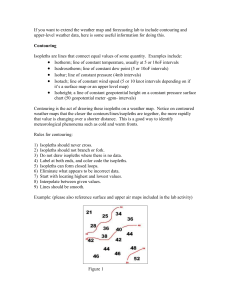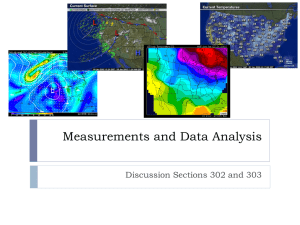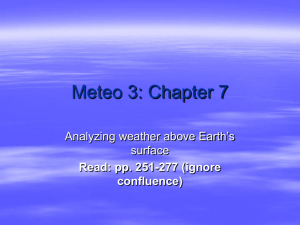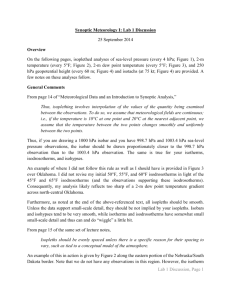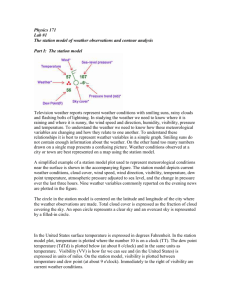211lecture3_wxmaps
advertisement
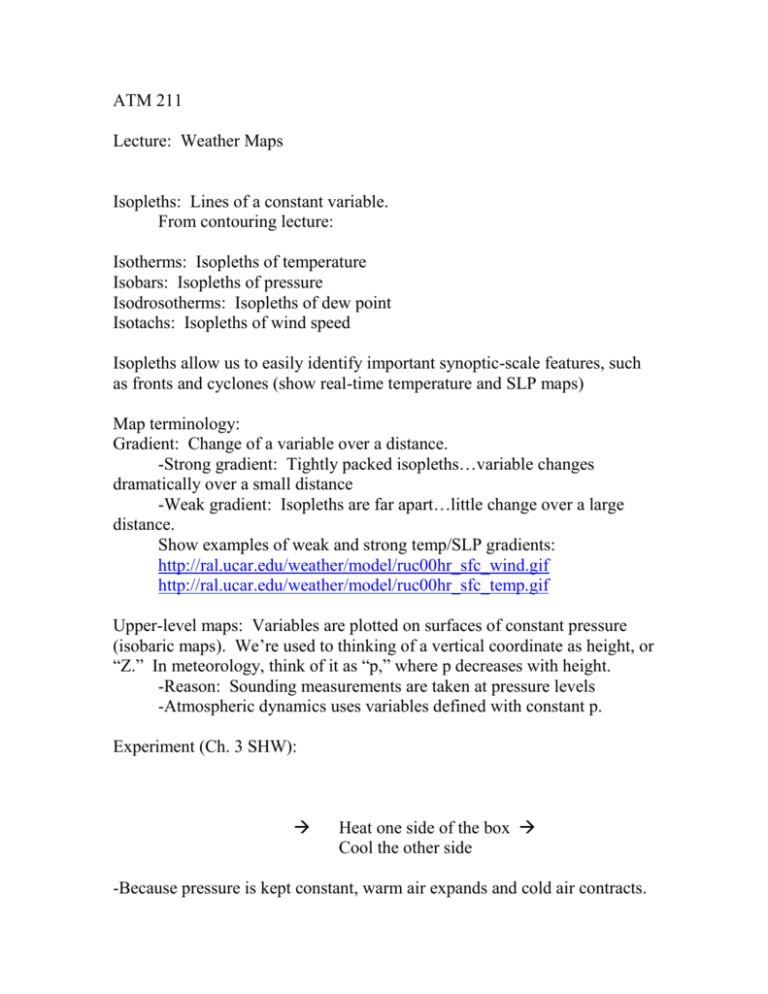
ATM 211 Lecture: Weather Maps Isopleths: Lines of a constant variable. From contouring lecture: Isotherms: Isopleths of temperature Isobars: Isopleths of pressure Isodrosotherms: Isopleths of dew point Isotachs: Isopleths of wind speed Isopleths allow us to easily identify important synoptic-scale features, such as fronts and cyclones (show real-time temperature and SLP maps) Map terminology: Gradient: Change of a variable over a distance. -Strong gradient: Tightly packed isopleths…variable changes dramatically over a small distance -Weak gradient: Isopleths are far apart…little change over a large distance. Show examples of weak and strong temp/SLP gradients: http://ral.ucar.edu/weather/model/ruc00hr_sfc_wind.gif http://ral.ucar.edu/weather/model/ruc00hr_sfc_temp.gif Upper-level maps: Variables are plotted on surfaces of constant pressure (isobaric maps). We’re used to thinking of a vertical coordinate as height, or “Z.” In meteorology, think of it as “p,” where p decreases with height. -Reason: Sounding measurements are taken at pressure levels -Atmospheric dynamics uses variables defined with constant p. Experiment (Ch. 3 SHW): Heat one side of the box Cool the other side -Because pressure is kept constant, warm air expands and cold air contracts. -Now, the 700 mb level is slanted! -A look from above (700 mb map with contours of height): -As we know, it is on average warmer in the tropical latitudes than at high latitudes, so pressure surfaces generally slope down with increasing latitude. Show real-time 700-mb or 500-mb map to prove this. -We can also equate height contours on a pressure level to pressure contours on a height level (Fig. 3.4). -Locally low “heights” are equivalent to locally low “pressure.” Upper-level weather map terminology: -Trough: Locally low heights…a “dip,” or “valley” in the jet stream -Ridge: Locally high heights -As a general rule, upper-level troughs are associated with colder temperatures (ridgeswarmer) Northern Hemisphere wind flow: -Low pressure/height is on the left. -Counter-clockwise (cyclonic) around low pressure/height -Clockwise (anticyclonic) around high pressure/height -In the upper-troposphere, generally west to east (with low heights on the “left.”) In general, the large-scale wind flow is parallel to isobars (isoheights) with the exception of at/near the surface. Show examples from RAP. Typical heights of pressure levels (remember this from TTAA): Pres. Level (mb) 925 Approx. Height 800 m 850 700 500 300 250 200 1.5 km 3 km 5.5 km 9 km 10.5 km 12 km Upper-level maps and common variables: 850 mb: Temperature and Height. Lower troposphere, ideal for temperatures. Easy to find fronts and cyclones. 700 mb: Relative humidity and Height (also omega, or UVM). Tends to be near cloud levels associated with cyclones, so analyzing RH at 100% = clouds. 500 mb: Vorticity and Height 300/250/200 mb: Isotachs and Height (Jet streams, easy to identify major troughs and ridges) Thickness: The height difference between two pressure levels. -The colder the average temperature is (in a column between two pressure levels), the lower the thickness is. -Why? Because increasing the temperature lowers the density and increases the volume: Ideal Gas Law: p = RT, or p = (m/V)RT Increasing T with constant p requires to decrease, or V to increase. Often, the 1000-500 mb thickness is a good temperature guide for the lower troposphere. Typical 1000-500 mb thickness = 5500 m (550 dam) 540 dam = Approx. rain/snow line <500 dam = Arctic airmass >570 dam = Warm airmass. (Show GFS thickness field).
